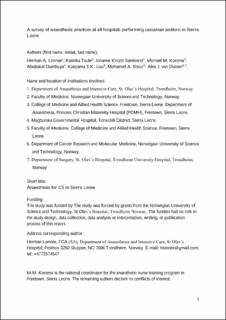| dc.contributor.author | Lonnee, Herman | |
| dc.contributor.author | Taule, Katinka | |
| dc.contributor.author | Sandvand, Johannes Knoph | |
| dc.contributor.author | Koroma, Michael M. | |
| dc.contributor.author | Dumbuya, Abubakar | |
| dc.contributor.author | Jusu, Kakpama S.K. | |
| dc.contributor.author | Shour, Mohamed A. | |
| dc.contributor.author | van Duinen, Aalke Johan | |
| dc.date.accessioned | 2021-06-07T08:03:23Z | |
| dc.date.available | 2021-06-07T08:03:23Z | |
| dc.date.created | 2020-12-15T11:43:37Z | |
| dc.date.issued | 2020 | |
| dc.identifier.citation | Acta Anaesthesiologica Scandinavica. 2020, 1-16. | en_US |
| dc.identifier.issn | 0001-5172 | |
| dc.identifier.uri | https://hdl.handle.net/11250/2758089 | |
| dc.description.abstract | Background
Providing safe anaesthesia is essential when performing caesarean sections, one of the most commonly performed types of surgery. Anaesthesia-related causes of maternal mortality are generally considered preventable. The primary aim of our study was to assess the type of anaesthesia used for caesarean sections in Sierra Leone. Secondary aims were to identify the type and training of anaesthesia providers, availability of equipment and drugs and use of perioperative routines.
Methods
All hospitals in Sierra Leone performing caesarean sections were included. In each facility, one randomly selected anaesthesia provider was interviewed face-to-face using a predefined questionnaire.
Results
In 2016, 36 hospitals performed caesarean sections in Sierra Leone. The most commonly used anaesthesia method for caesarean section was spinal anaesthesia (63%), followed by intravenous ketamine without intubation; however, there was a wide variety between hospitals. Of all anaesthesia providers, 33% were not qualified to provide anaesthesia independently, as stipulated by local regulations. Of those, 50% expressed high confidence in their skills to handle obstetric emergencies. There were discrepancies among hospitals in the availability of essential drugs, the use of post-operative recovery and the presence of a functioning blood bank.
Conclusion
Anaesthesia for caesarean sections in Sierra Leone showed a predominance for spinal anaesthesia. The workforce consisted mainly of non-physicians, of which a third was not trained to provide anaesthesia independently. Both the type of anaesthesia and the presence of qualified anaesthetic providers was widely variable between hospitals. Significant gaps were identified in the availability of equipment, essential drugs and perioperative routines. | en_US |
| dc.language.iso | eng | en_US |
| dc.publisher | Wiley | en_US |
| dc.title | A survey of anaesthesia practices at all hospitals performing caesarean sections in Sierra Leone | en_US |
| dc.type | Peer reviewed | en_US |
| dc.type | Journal article | en_US |
| dc.description.version | acceptedVersion | en_US |
| dc.source.pagenumber | 1-16 | en_US |
| dc.source.journal | Acta Anaesthesiologica Scandinavica | en_US |
| dc.identifier.doi | 10.1111/aas.13736 | |
| dc.identifier.cristin | 1859954 | |
| dc.description.localcode | Locked until 10.11.2021 due to copyright restrictions. This is the peer reviewed version of an article, which has been published in final form at [https://doi.org/10.1111/aas.13736]. This article may be used for non-commercial purposes in accordance with Wiley Terms and Conditions for Self-Archiving. " | en_US |
| cristin.ispublished | true | |
| cristin.fulltext | original | |
| cristin.fulltext | postprint | |
| cristin.qualitycode | 1 | |
